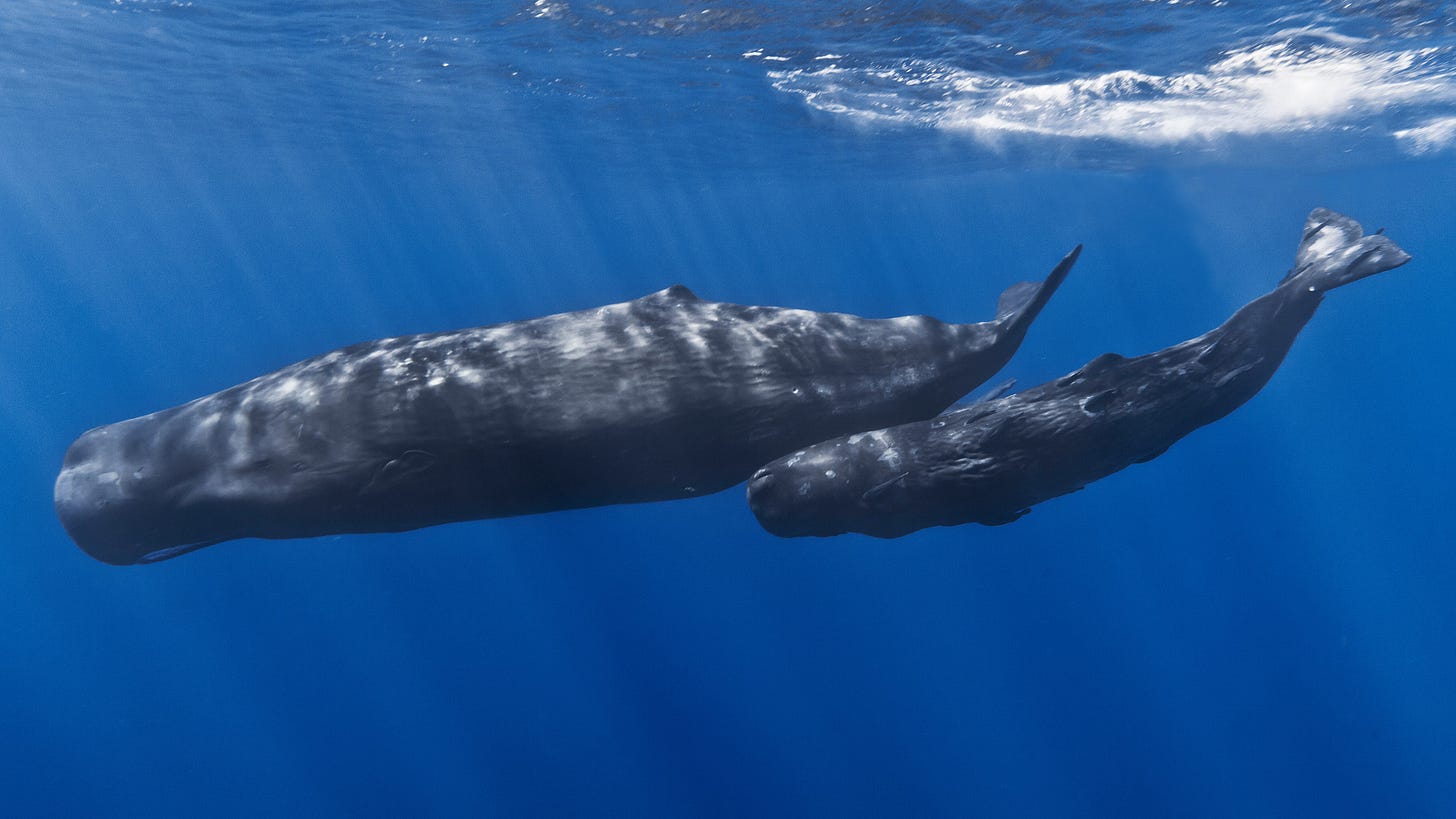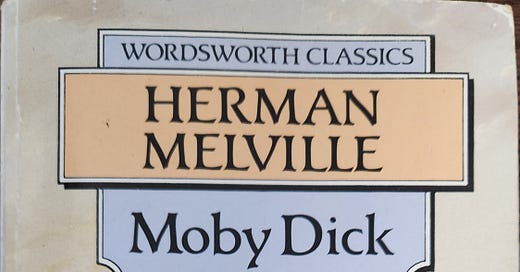Book Review: Moby Dick
“To produce a mighty book, you must choose a mighty theme.”
—Herman Melville
A leading contender for the title of “The Great American Novel”, Melville’s magnum opus Moby Dick is full of mighty themes, addressing topics from philosophy and religion to colonialism and revenge. But the main focus is right there in the book’s subtitle: The Whale. Above all, Moby Dick is a book about whaling. If pointing that out might seem obvious, it still doesn’t do justice to the depth to which Melville examines every aspect of this profession. What we have here is the perfect union of author, who examines his subject more comprehensively than the reader could ask for, and subject rich with layers of meaning. For all its reputation as a daunting, impenetrable tome, Moby Dick turns out to be an absorbing read—at turns thoughtful, exciting, informative, and yes, even funny.
The economic importance of whaling in the 19th century is perhaps comparable to that of petroleum in the 20th and 21st centuries. Widespread commercial whaling began in the 17th century with the construction of special whaling ships, and steadily grew in importance. The industry’s lucrativeness stemmed primarily from the use of blubber to produce whale oil, vital for lighting lamps as well as lubricating machines during the Industrial Revolution. Most prized of all was the sperm whale, due to the thick waxy substance known as spermaceti located in its head cavities. Besides burning with a particularly bright light, spermaceti was used to produce cosmetics and textiles. Other parts of the whale also had commercial uses, from baleen to ivory. The United States became the leading whaling nation in the late colonial period, with the New England island of Nantucket dominating the U.S. whaling industry.
All this provides the background for Moby Dick, much of it detailed in the book itself. What stands out about Melville’s novel, more than any other work of fiction I’ve read, is its painstaking detail in laying out facts and figures that provide context to its story. Our narrator, Ishmael, tells the reader everything we’d like to know about whales and the whaling industry, and then some. Entire chapters focus on cetology, explaining the different kinds of whale, the biology of the sperm whale in particular; the whale as a dish, the whale skeleton, the whale as depicted in art and literature. Ishmael describes life on board a whaling vessel and the process of hunting, catching, and processing whales. Interspersed throughout are vignettes and stories of the sailors who manned whaling vessels, both on and off the Pequod—the vessel on which Ishmael serves. Melville keeps his novel interesting by throwing in a wide variety of textual forms, from prose to songs, sermons, and play directions.

The quality that stands out most about Ishmael from the beginning is his tendency to overthink things. This is obvious right from the opening when Ishmael arrives at an inn in New Bedford, Massachusetts, which is so crowded he has to share a bed with a tattooed Polynesian named Queequeg. Ishmael spends so much time staring at the bed as Queequeg sleeps in it, contemplating what he should do, that it becomes comical. There’s more than a hint of homoeroticism in the degree to which Ishmael develops warm feelings for Queequeg as the two sleep together and bond, despite his often describing Queequeg to the reader as a “savage”.
It would be easy to dismiss this as garden-variety 19th-century racism, and no doubt that does inform some of the ways Melville describes Indigenous or Black characters. But there’s also a self-awareness that feels rare for the time, as when Ishmael describes white men as “savage” in their own way, or compares Christianity to Queequeg’s native religion in roughly equal terms. Scholar Martha Vick points out that Ishmael when considering Queequeg contrasts the “illusion of his darkness” with the “reality of his goodness”, implicitly questions prevalent racial hierarchies. Ishmael also freely allows that Queequeg is a superior harpooner.
Ishmael’s propensity for “overthinking” is in fact an essential part of what makes Moby Dick so enjoyable. Almost every aspect of whaling and Ishmael’s journey is covered in extreme detail, which helps us find significance in the mundane. Melville’s thorough description of whales and whaling were so extensive, for many years after its publication the book was found in the non-fiction section of libraries as a textbook on whaling. In such passages we gain an appreciation and respect for the size and power of the sperm whale, and Moby Dick himself. That the titular whale does not appear until the last 30 pages of this long novel—583 pages in the Wordsworth Classics edition—turns out to be a stroke of brilliance on Melville’s part. It builds anticipation for the great white whale, making his eventual appearance all the more dramatic. Steven Spielberg used a similar tactic in Jaws when he kept the shark largely hidden until the film’s climax.

The most memorable character in Moby Dick is Captain Ahab, whose obsessive quest for the white whale that bit off his leg made him the archetypal literary figure of revenge. More than once I was reminded of references to the character in Star Trek, from Khan quoting Ahab to the comparison of Jean-Luc Picard to Ahab as he seeks revenge against the Borg. The lines writer Nicholas Meyer quotes in Star Trek II: The Wrath of Khan are the ones that bookend Ahab’s quest, two of the novel’s greatest lines. The first is when he announces to the Pequod crew his hunt for Moby Dick: “I'll chase him round Good Hope, and round the Horn, and round the Norway Maelstrom, and round perdition's flames before I give him up.” The second come from some of Ahab’s last words in the novel, directed at the target of his vengeance: “Towards thee I roll, thou all-destroying but unconquering whale; to the last I grapple with thee; from hell’s heart I stab at thee; for hate’s sake I spit my last breath at thee.”
There’s an inherent fascination to the sea. Its vastness and mystery, the diverse ecology of ocean creatures of whom whales are the largest, all create a sense of awe. Even today, more than 170 years after Melville published his great work, the depths of the world’s oceans remain largely unexplored. James Cameron, whose interest in deep-sea exploration is widely documented, may have taken some influence from Moby Dick in his depiction of the intelligent Tulkun whales in Avatar: The Way of Water. The Tulkun in that film are commercially hunted for a substance in their brains called “amrita”, which stops the aging of humans. Parallels are clear to the economic importance of spermaceti in 19th-century whaling.
Moby Dick is a dense read, to be sure. But it’s the very richness of the text and the scope of the author’s vision that make it so rewarding, easily one of the greatest novels I’ve ever read. Its legendary status is well deserved.




